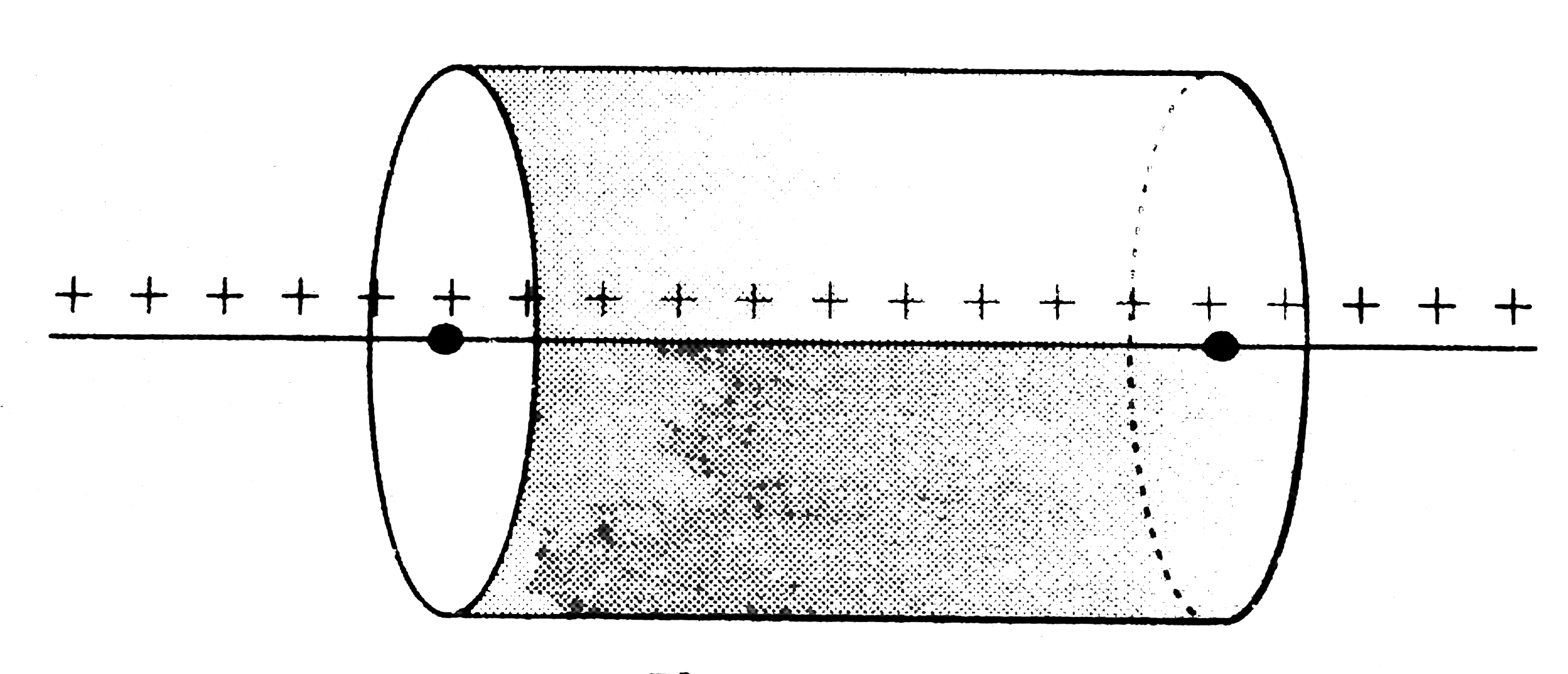An infinite cylinder of radius ro, carrying linear charge density λ. The equation of the equipotential surface for the cylinder is
r=r0eπε0[V(r)+V(r0)]λ
r=r0e2πε0[V(r)−V(r0)]λ2
r=r0e−2πε0[V(r)=V(r0)]λ
r=r0e−2πε0[V(r)−V(r0)]λ
The correct Answer is:C
To find the equation of the equipotential surface for an infinite cylinder of radius R0 carrying a linear charge density λ, we can follow these steps:
Step 1: Understand the setup
We have an infinite cylinder with radius R0 and a linear charge density λ. The electric field around a charged cylinder can be derived using Gauss's law.
Step 2: Apply Gauss's Law
Consider a cylindrical Gaussian surface of radius r (where r>R0) and length L. According to Gauss's law:
ΦE=Qencϵ0
where ΦE is the electric flux through the Gaussian surface and Qenc is the charge enclosed by the Gaussian surface.
Step 3: Calculate the charge enclosed
The charge enclosed by the Gaussian surface is:
Qenc=Lλ
Step 4: Calculate the electric field
The electric field E at a distance r from the axis of the cylinder can be expressed as:
E⋅(2πrL)=Lλϵ0
From this, we can solve for E:
E=λ2πϵ0r
Step 5: Relate electric field to potential difference
The potential difference V between two points in an electric field is given by:
V=−∫Edl
For our case, we want to find the potential difference between the surface of the cylinder (at R0) and a point at distance r:
Vr−VR0=−∫rR0Edl
Step 6: Substitute the expression for E
Substituting the expression for E:
Vr−VR0=−∫rR0λ2πϵ0ldl
Step 7: Evaluate the integral
Evaluating the integral:
Vr−VR0=−(λ2πϵ0lnl)rR0
This gives:
Vr−VR0=−λ2πϵ0(lnr−lnR0)
=−λ2πϵ0ln(rR0)
Step 8: Rearranging the equation
Rearranging gives us:
ln(R0r)=−2πϵ0λ(Vr−VR0)
Step 9: Final equation for the equipotential surface
Exponentiating both sides leads to:
r=R0e−2πϵ0λ(Vr−VR0)
This is the equation of the equipotential surface for the infinite charged cylinder.
We have an infinite cylinder with radius R0 and a linear charge density λ. The electric field around a charged cylinder can be derived using Gauss's law.
Consider a cylindrical Gaussian surface of radius r (where r>R0) and length L. According to Gauss's law:
ΦE=Qencϵ0
where ΦE is the electric flux through the Gaussian surface and Qenc is the charge enclosed by the Gaussian surface.
The charge enclosed by the Gaussian surface is:
Qenc=Lλ
The electric field E at a distance r from the axis of the cylinder can be expressed as:
E⋅(2πrL)=Lλϵ0
From this, we can solve for E:
E=λ2πϵ0r
The potential difference V between two points in an electric field is given by:
V=−∫Edl
For our case, we want to find the potential difference between the surface of the cylinder (at R0) and a point at distance r:
Vr−VR0=−∫rR0Edl
Substituting the expression for E:
Vr−VR0=−∫rR0λ2πϵ0ldl
Evaluating the integral:
Vr−VR0=−(λ2πϵ0lnl)rR0
This gives:
Vr−VR0=−λ2πϵ0(lnr−lnR0)
=−λ2πϵ0ln(rR0)
Rearranging gives us:
ln(R0r)=−2πϵ0λ(Vr−VR0)
Exponentiating both sides leads to:
r=R0e−2πϵ0λ(Vr−VR0)
Topper's Solved these Questions
- ELECTROSTATIC POTENTIAL AND CAPACITANCE BOOK - NCERT FINGERTPS ENGLISHCHAPTER - ELECTROSTATIC POTENTIAL AND CAPACITANCE EXERCISE - EXEMPLAR PROBLEMS
3 Videos
- ELECTROSTATIC POTENTIAL AND CAPACITANCE BOOK - NCERT FINGERTPS ENGLISHCHAPTER - ELECTROSTATIC POTENTIAL AND CAPACITANCE EXERCISE - ASSERTION & REASON
15 Videos
- ELECTROSTATIC POTENTIAL AND CAPACITANCE BOOK - NCERT FINGERTPS ENGLISHCHAPTER - ELECTROSTATIC POTENTIAL AND CAPACITANCE EXERCISE - Assertion And Reason
15 Videos
- ELECTROMAGNETIC WAVESBOOK - NCERT FINGERTPS ENGLISHCHAPTER - ELECTROMAGNETIC WAVESEXERCISE - Assertion And Reason
15 Videos
- MAGNETISM AND MATTER BOOK - NCERT FINGERTPS ENGLISHCHAPTER - MAGNETISM AND MATTER EXERCISE - NCERT Exemplar
5 Videos
Similar Questions
An infinite sheet of charge has surface charge density σ . The separation between two equipotential surfaces, whose potential differ by V is:
View SolutionAn infinite sheet of charge has a surfaces charge density of 10−7Cm2. The separation between two equipotential surfce whose potentials differ by 5V is
View SolutionFind the electric field due to an infinitely long cylindrical charge distribution of radius R and having linear charge density λ at a distance half of the radius from its axis.
View SolutionAn infinite nonconducting sheet of charge has a surface charge density of 107C/m2. The separation between two equipotential surfaces near the whose potential differ by 5V is
View SolutionFind the moment of inertia of a solid cylinder of mass M and radius R about a line parallel to the axis of the cylinder and on the surface of the cylinder.
View SolutionA coaxial cylinder made of glass is immersed in a-liquid of surface tension S. The radius of the inner and outer surface of the cylinder are R1andR2 respectively . Height till which liquid will rise is (Density of liquid is ρ )
View SolutionA charge particle q is released at a distance R∘ from the infinite long wire of linear charge density λ. Then velocity will be proportional to (At distance R from the wire)
_2019_CBT2_E01_009_Q01.png)
View SolutionConsider an infinite line charge having uniform linear charge density and passing through the axis of a cylinder is removed.

View SolutionA very long uniformly charged cylinder (radius R) has a surface charge density σ . A very long uniformaly charged line charge( linear charge density λ) is placed along the ctlinder axis. If electric field intensity vector outside the cylinder is zerom then :
View SolutionA solid non-conduction cylinder of radius R is charge such that volume charge density is proporation to r where r is distance from axis. The electric field E at a distance r(r<R) well depend on r as.
View Solution
